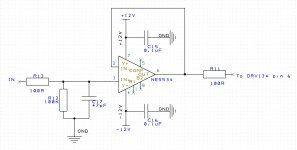Hi, just ordered a 125asx2 off ebay and a case from Ghentaudio. I was hoping to run this module in BTL mode and see that i need a converter to go from unbalanced to balanced.
The RTX module from Ghentaudio performs this task. There are 3 options,
1. 6gb gain 10kohm
2. 0db gain 10kohm
3. 0db gain 100k ohm
Which one do I choose and why?
Tks in advance for your replays
Plan on running these amps off the pre of my denon avr x4100
The RTX module from Ghentaudio performs this task. There are 3 options,
1. 6gb gain 10kohm
2. 0db gain 10kohm
3. 0db gain 100k ohm
Which one do I choose and why?
Tks in advance for your replays
Plan on running these amps off the pre of my denon avr x4100
In case anyone is wondering this is the response I got from Ghentaudio
Hello,
6db will output bigger audio volume, just it.
For input buffer, usually higher input impedance would be better than lower input impedance, so 100K is better than 10K.
Just the standard 10K/6db is the cheapest one, so it's sold out.
But if you want better audio quality, certainly 100K input impedance would better.
Thanks
Ghent
Hello,
6db will output bigger audio volume, just it.
For input buffer, usually higher input impedance would be better than lower input impedance, so 100K is better than 10K.
Just the standard 10K/6db is the cheapest one, so it's sold out.
But if you want better audio quality, certainly 100K input impedance would better.
Thanks
Ghent
I'm working with some Ghent RTX modules and rather than start a new thread hoped to keep everything in one spot.
Additional information on input impedance and gain:
The input impedance you'd choose is based off of your source's output impedance, for example, if you have a vintage tube preamp with a relatively high output impedance, you'd choose the RTX module with the 100k input impedance.
If you have a modern AVR or preamp with a low output impedance, you'd pick either the +6dB/10k or 0dB/10k RTX module based on the gain requirements of the system you're working with. In my current example, I'm helping a friend use a miniDSP 2x4HD driving a pair of ICEpower 1000ASP modules. The 2x4HD is rated at 2V RMS output (searching the web for actual measurements shows it's more like 1.88v RMS). The 1000ASP modules require 2.76-2.83v RMS to reach full power depending on the speaker load. He needs a minimum of 3.5dB more gain to drive the amps to full power, so we went with the +6dB/10k versions. If your source has enough output to drive your amp to full power, go with the 0dB/10k to maximize system noise performance.
Additional information on input impedance and gain:
The input impedance you'd choose is based off of your source's output impedance, for example, if you have a vintage tube preamp with a relatively high output impedance, you'd choose the RTX module with the 100k input impedance.
If you have a modern AVR or preamp with a low output impedance, you'd pick either the +6dB/10k or 0dB/10k RTX module based on the gain requirements of the system you're working with. In my current example, I'm helping a friend use a miniDSP 2x4HD driving a pair of ICEpower 1000ASP modules. The 2x4HD is rated at 2V RMS output (searching the web for actual measurements shows it's more like 1.88v RMS). The 1000ASP modules require 2.76-2.83v RMS to reach full power depending on the speaker load. He needs a minimum of 3.5dB more gain to drive the amps to full power, so we went with the +6dB/10k versions. If your source has enough output to drive your amp to full power, go with the 0dB/10k to maximize system noise performance.
The reverse side of the RTX v5.1 modules have pads for an additional opamp and supporting components, I assume these are used for the 100k input version. I drew out the circuit, it is fairly standard. The values I put in for the resistors and capacitors are my own estimates, feel free to use the best values for your application. You do need to remove R11 from the front side, and maybe R10, but it probably won't hurt anything.
